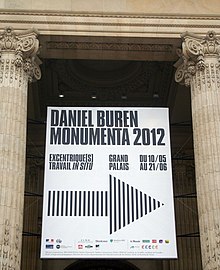Daniel Buren
He has created several world-famous installations, including "Les Deux Plateaux"(1985) in the Cour d'honneur of the Palais-Royal, and the Observatory of the Light in Fondation Louis Vuitton.
However, by 1965 – a year he spent in the Grapetree Bay Hotel on the Caribbean island of Saint Croix[2] where he was contracted to make frescoes – he had abandoned traditional painting for the 8.7 cm-wide vertical stripes, which alternated between white and one color, which have become his signature.
[citation needed] Denoting the trademark stripes as a visual instrument or "seeing tool," he invites viewers to take up his critical standpoint challenging traditional ideas about art.
[citation needed] For his first New York City solo show in 1973, Buren suspended a set of nineteen black and white striped squares of canvas on a cable that ran from one end of the John Weber Gallery to the other, out the window to a building on the other side of West Broadway and back.
Between 1966 and 1967, he joined forces with fellow artists Olivier Mosset, Michel Parmentier, and Niele Toroni to form the BMPT, whose intention was to reduce paintings to the most basic physical and visual elements through the systematic repetition of motifs.
He creates new spaces within existing environments such as city centers (A Colored Square in the Sky, 2007), public parks (La Cabane Éclatée aux 4 Salles, 2005), entire museums (The Eye of the Storm, 2005), and even beaches (Le Vent soufle où il veut, 2009).
It is a work in situ – for Tours Tram – three black and white stripes vertically, which will join the same horizontal marking on the ground, both at right angles to the doors' opening.
[12][13] In 2014, the rooftop of Modernist architect Le Corbusier's Cité Radieuse building in Marseilles hosted an installation of mirrors and coloured glass by Buren.
Défini, Fini, Infini (2014) was an installation for the Marseilles Modulor (MaMo), led by French designer Ora-Ïto, who in 2013 transformed the iconic rooftop into an international arts space.
[15] From 1966 to '67, Buren and the other BMPT artists staged a series of performances they called manifestations, in which the group made or exhibited their work in public as a critical encounter with audiences.
[16] Voile/Toile – Toile/Voile, a piece consisting of boat races followed by museum displays of sail-canvasses, was originally created for a regatta on the Wannsee, Berlin, in 1975 and later produced in Geneva (1979), Lucerne (1980), Villeneuve-d'Ascq (1983), Lyon-Villeurbanne (1998), Tel Aviv (1999), Sevilla (2004), and Grasmere (2005).
[22] In 1971, Buren devised a banner, 20 by 10 metres, with white and blue stripes on both sides to be hung at the Guggenheim Museum in New York in a big international group show, conceived to encourage artists to exploit the building's space.
In 1986, when François Mitterrand was president of France, Buren attained leading artist status after he created Les Deux Plateaux (1985–86), a work in situ for the Cour d'honneur at the Palais Royal in Paris.
In December 2006 Buren won the competition to make Arcos Rojos/Arku Gorriaka, a new major project for the iconic Puente de La Salve bridge next to the Guggenheim Museum in Bilbao while, in February 2007, the Musée Fabre in Montpellier re-opened with a new permanent commission.
[26] The fifth artist ever to fill the space of the Grand Palais on the occasion of the Monumenta exhibition, Buren conceived Excentrique(s) in 2012, a giant cluster of colored, transparent plastic discs, which overlap to form a colourful canopy.
In 1990, New Zealand honored him as a Living Treasure for their 150th anniversary and in 1991 he received the International Award for the Best Artist given in Stuttgart, Germany, followed by the Grand Prix National de Peinture in France, 1992.





